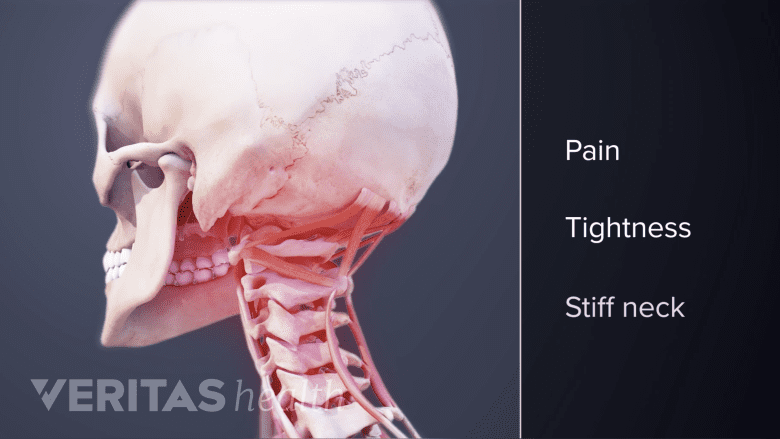There are many potential symptoms of cervical foraminal stenosis, ranging from a mild neck ache to severe, debilitating pain that goes into the arm. The specific symptoms can vary depending on which spinal nerve root is being compressed as well as the severity of the stenosis.
In This Article:
- Cervical Foraminal Stenosis
- Cervical Foraminal Stenosis Symptoms
- Cervical Foraminal Stenosis Causes and Diagnosis
- Cervical Foraminal Stenosis Treatment
- Cervical Foraminal Stenosis Surgery
Common Cervical Foraminal Stenosis Symptoms

Cervical foraminal stenosis symptoms include neck stiffness, limited motion, and muscle spasms.
Cervical foraminal stenosis symptoms may include one or more of the following:
- Neck pain that can range from a general achiness to intense or burning.
- Neck stiffness or reduced range of motion due to neck pain, swelling, and/or muscle spasms.
- Cervical radicular pain which can feel electric shock-like and radiates from the neck into the shoulder, arm, hand, and/or fingers.
- Cervical radiculopathy which can include pins-and-needles tingling, numbness, problems with reflexes, and/or weakness that goes into the shoulder, arm, hand, and/or fingers.
Cervical foraminal stenosis symptoms are typically one-sided, such as going into one arm rather than both. When foramina on both sides of the neck are narrowed and affecting nerve roots on each side of the cervical spine, the symptoms may be bilateral (both sides). When neurological deficits are experienced on both sides of the body, it could also be a sign of myelopathy (spinal cord compression).
Onset of Cervical Foraminal Stenosis Symptoms
Certain head movements, like twisting, can exacerbate nerve compression and worsen the pain.
Symptoms of cervical foraminal stenosis may:
- Develop gradually. Cervical foraminal stenosis most commonly develops slowly with initial symptoms feeling minor or intermittent. While the overall process of spinal degeneration from aging and wear-and-tear takes many years, the actual rate in which discs degenerate and bone spurs grow needs more research.
- Flare-up during certain activities. Some movements or positions, such as twisting the head to one side, may further compress or inflame the nerve and worsen the pain.
- Completely go away before recurring. After a flare-up, symptoms may completely alleviate for a short or long duration before recurring. When symptoms recur, they can range anywhere from less intense to more severe.
While the process of foraminal narrowing cannot be cured and continues to progress, the symptoms may not necessarily worsen over time.
Cervical Foraminal Stenosis Symptoms by Location
While innervation can vary from person to person, common symptom patterns by spinal nerve root include:
- C5 spinal nerve. Pain, tingling, and/or numbness may radiate from the neck into the shoulder and/or down the thumb-side of the forearm. The shoulder or upper arm may also experience reduced strength.
- C6 spinal nerve. Pain, tingling, and/or numbness may travel down the arm and into the thumb-side of the hand. Reduced strength may occur in the front of the upper arm (biceps) or wrist.
- C7 spinal nerve. Pain, tingling, and/or numbness may radiate down the middle of the arm and/or into the middle finger. Weakness may be felt in the back of the upper arm (triceps).
- C8 spinal nerve. Pain, tingling, and/or numbness may be felt on the pinky side of the hand. Reduced handgrip strength may also occur. Motor and/or reflex deficits may also occur and vary depending on the level of compression. Numbness, weakness, and/or diminished reflexes may be experienced anywhere in the shoulder, arm, hand, or fingers.
See All About the C7-T1 Spinal Segment (Cervicothoracic Junction)
Read more about Cervical Spinal Nerves
When to Seek Medical Attention
When unexplained pins-and-needles tingling, numbness, and/or weakness are experienced in the shoulder, arm, or hand, it requires prompt medical attention. Any signs or symptoms related to nerve compression or inflammation, such as numbness or weakness, may benefit from early treatment before the nerve damage worsens or becomes permanent. In addition, any unexplained neck pain that does not improve within a couple of weeks, or severe pain that interferes with daily activities, needs to be evaluated by a doctor.

